Navico Hawks 2017: “Full boat integration into one display cluster”
The Miami Boat Show was loaded with marine electronics news, but first let’s visit the Navico writers event held at Hawks Cay, Florida, earlier this month. Deeper still – Mercury engine integration, B&G Zeus PredictWind weather routing, the Halo radar VelocityTrack Doppler upgrade, Navionics SonarChart Live everywhere, Simrad’s new 3kW 3-channel S5100 super sonar, and Lowrance Carbon (Gen3) MFDs are some of the goodies that were demonstrated and/or discussed. But I was especially taken with CEO Leif Ottosson’s opening “big picture” presentation and think it’s valuable to anyone interested in the future of boating…
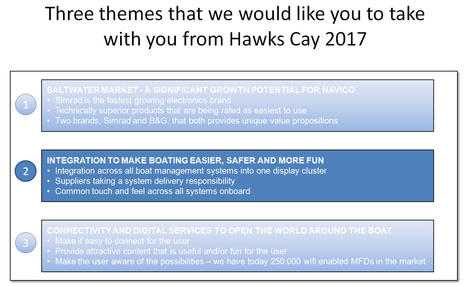 Actually, I first photographed Leif talking about Navico integration back in 2011 in Spain, but the realities have come a long way since then, and his concept of where it’s all headed has evolved at least as quickly and broadly. “Full boat integration into one display cluster” means a lot more than “like a modern automobile” nowadays, and I believe it’s going to happen.
Actually, I first photographed Leif talking about Navico integration back in 2011 in Spain, but the realities have come a long way since then, and his concept of where it’s all headed has evolved at least as quickly and broadly. “Full boat integration into one display cluster” means a lot more than “like a modern automobile” nowadays, and I believe it’s going to happen.
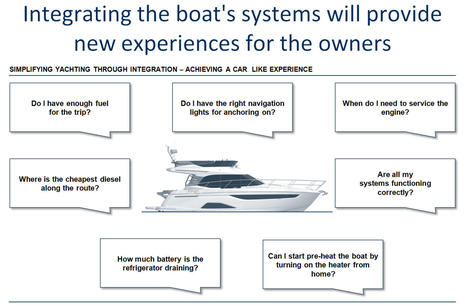 Nonetheless, the typically integrated modern car does offer some of the features that could make boating less stressful and more fun; hence the subtitle of this slide about boater expectations that went up early in the presentation.
Nonetheless, the typically integrated modern car does offer some of the features that could make boating less stressful and more fun; hence the subtitle of this slide about boater expectations that went up early in the presentation.
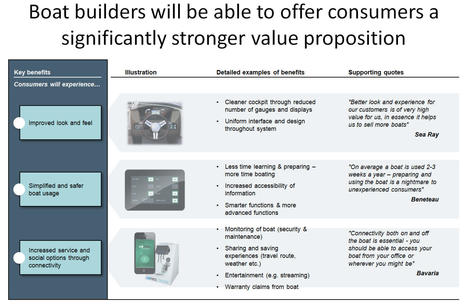 But unlike the automobile industry, there are very few boatbuilders with the resources needed to develop the level of electronic integration Leif envisions (and, in fact, I wonder if any should try). One slide I’m leaving out showed more quotes from nine builders, including, “Plug and play is key for integration, we don’t have technically skilled labor in our factories.” Yike! Many builders understandably hunger for some major system supplier like Navico to take responsibility for all or most of the systems, and it’s easy to imagine how better, more reliable, yet less expensive boats could result.
But unlike the automobile industry, there are very few boatbuilders with the resources needed to develop the level of electronic integration Leif envisions (and, in fact, I wonder if any should try). One slide I’m leaving out showed more quotes from nine builders, including, “Plug and play is key for integration, we don’t have technically skilled labor in our factories.” Yike! Many builders understandably hunger for some major system supplier like Navico to take responsibility for all or most of the systems, and it’s easy to imagine how better, more reliable, yet less expensive boats could result.
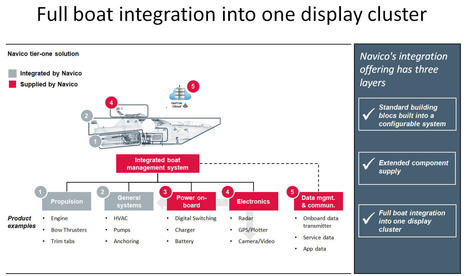 So it’s great to see how Navico pictures not only creating more of the system elements, but also supplying elements they don’t manufacture. And the full concept seems to include supporting third party hardware through the design and purchase process during installation and out in the field.
So it’s great to see how Navico pictures not only creating more of the system elements, but also supplying elements they don’t manufacture. And the full concept seems to include supporting third party hardware through the design and purchase process during installation and out in the field.
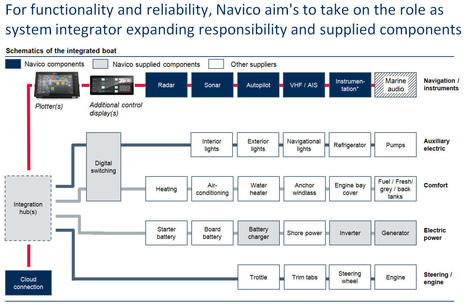 Ottosson emphasized that integration does not just mean digital switching and monitoring, though as you’ll see below Navico’s new partnership with Naviop has a trailblazing aspect. The real deal in Leif’s view starts with a single source integrator, lives on board in common display clusters, and includes system updating, social features, diagnosis, prognosis, and more in an integrated cloud off the boat. And current Navico displays are already showing off some of what he means.
Ottosson emphasized that integration does not just mean digital switching and monitoring, though as you’ll see below Navico’s new partnership with Naviop has a trailblazing aspect. The real deal in Leif’s view starts with a single source integrator, lives on board in common display clusters, and includes system updating, social features, diagnosis, prognosis, and more in an integrated cloud off the boat. And current Navico displays are already showing off some of what he means.
In One Display Cluster
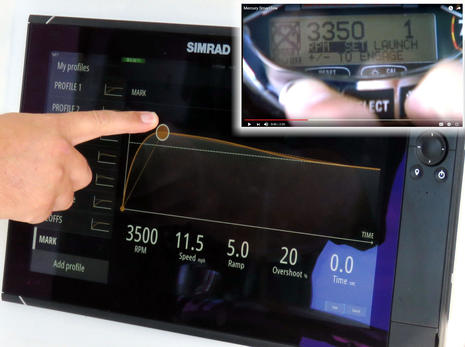 Here’s a stunning example of display integration with propulsion systems I saw fully functioning off Hawks Cay. Last year we detailed the tight Mercury/Navico partnership seen in VesselView, but now there’s even more engine control available where you really want it. Mercury’s clever Smart Tow assistance for launching water skiers and wakeboarders has been around for a while, as you can see in this 2008 video. But the SC100/1000 gauge setup routine sure looks clunky compared to what’s now possible on the Simrad NSS16 evo3 screen above, or on many other Navico MFDs or Merc’s own VesselViews.
Here’s a stunning example of display integration with propulsion systems I saw fully functioning off Hawks Cay. Last year we detailed the tight Mercury/Navico partnership seen in VesselView, but now there’s even more engine control available where you really want it. Mercury’s clever Smart Tow assistance for launching water skiers and wakeboarders has been around for a while, as you can see in this 2008 video. But the SC100/1000 gauge setup routine sure looks clunky compared to what’s now possible on the Simrad NSS16 evo3 screen above, or on many other Navico MFDs or Merc’s own VesselViews.
In the photo above, the operator is fingetip adjusting a custom profile that will ramp up quickly and even overshoot the desired 3,500 towing RPM to, say, pop a heavy slalom skier (or three) onto plane. The setup was easy, the driver could focus more on watersports safety once he’d initiated the profile (with a screen command and full throttle), and the skier(s) can expect the same tow time after time. Simply backing off the throttle disengages the automatic RPM (or speed) control, though I suspect that’s only a hint of the safety engineering that’s gone into permitting high speed throttle control on a multifunction display.
Current VesselView software can also manage Cruise Control, even at high speeds, and in Miami Navico announced SmartCraft autopilot integration that will put capabilities like route steering and active trim control onto the big display clusters of boats with Mercury Joystick Piloting. But Navico’s integration strategy is inclusive, not exclusive, and that, fortunately, seems the trend. In Miami, Navico also announced advanced Yamaha engine integration, and so did Furuno, and so did Garmin!
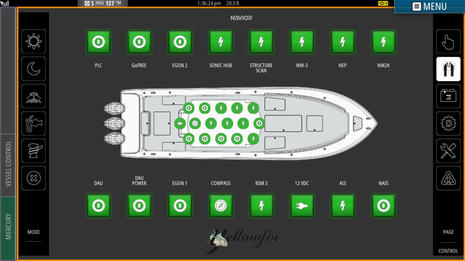 The same Team Simrad Yellowfin 36 with the VesselView engine monitoring and control — note the screen tabs left above — also sports an extensive Naviop monitoring and digital switching system (with demo video on gorgeous Venician water taxi here). Interestingly, the mode screen above was designed to show Captain Mark Maus all the devices set to be powered up when he leaves the dock. In other words: One glance, all green, good to go.
The same Team Simrad Yellowfin 36 with the VesselView engine monitoring and control — note the screen tabs left above — also sports an extensive Naviop monitoring and digital switching system (with demo video on gorgeous Venician water taxi here). Interestingly, the mode screen above was designed to show Captain Mark Maus all the devices set to be powered up when he leaves the dock. In other words: One glance, all green, good to go.
Here Mark is demonstrating a screen full of switches for lights, pumps, and even a huge (fish) “coffin box” he could open and close from the helm. This was all impressive — imagine the large confusing panel of circuit breakers replaced — and I knew that backup switching is built in from my first look at Naviop’s tech in late 2015.
But the big deal about Naviop in terms of big picture integration may be the fact that the Navico Operating System (NOS) is using a browser to display these slick controls. Geeky as it may sound, Navico product managers regard this as key, because it means third party developers like Naviop can manage their app integration with much less coding and validation effort on Navico’s part. Moreover, product managers at two other major marine electronics companies told me in Miami that they too are looking at HTML5 browsing as a possible way to make third party integration easier to enable and quicker to update.
Kees enthused about this HTML5 “app” technique after seeing the new evo3 and Zeus3 MFDs at METS, but, to be clear, that’s an NSS evo2 using the NOS browser above. While Evo3 and Zeus3 definitely have improved IPS screens and goodies like the custom function (Wheel) key — apparently, I will soon be able to use that to one-tap toggle screen windows to full screen and back (hurray) — most new NOS features work on older MFDs too, Lowrance’s often included.
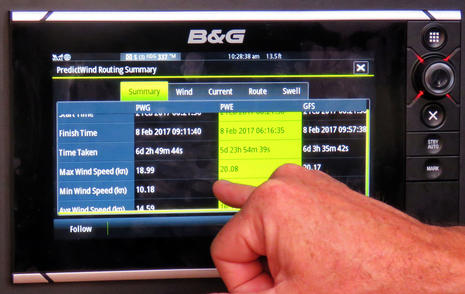 So here’s a B&G Zeus2 showing off its new ability to run PredictWind weather routing — video walkthrough here — which worked quite smoothly on board the racy J111 Utah just using a cell phone to make the needed WiFi-to-Internet connection. It was a challenging route, too, as suggested by the 5 and 6-day possible passage times shown on the Summary screen above, and especially when you look at the four possible routes based on different weather models overlaid on the chart screen below.
So here’s a B&G Zeus2 showing off its new ability to run PredictWind weather routing — video walkthrough here — which worked quite smoothly on board the racy J111 Utah just using a cell phone to make the needed WiFi-to-Internet connection. It was a challenging route, too, as suggested by the 5 and 6-day possible passage times shown on the Summary screen above, and especially when you look at the four possible routes based on different weather models overlaid on the chart screen below.
A lot of calculating seemed to materialize very quickly, probably because it largely happens on PredictWind’s own servers, which also means that the data transfer is actually modest and can be done with fairly narrowband satellite. Departure planning is also supported, and if you’re unfamiliar with these valuable services a neat place to learn is the free FastSeas site discussed here recently.
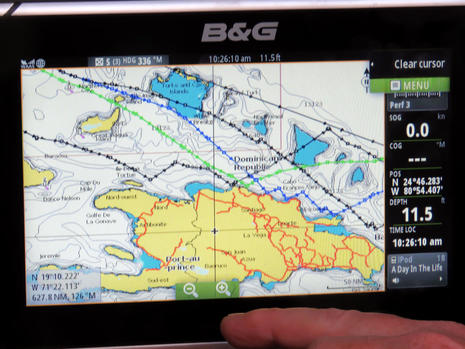 Weather routing is normally done on a PC or tablet, and I believe that you can still use your PredictWind subscription on those platforms. But wouldn’t it be nice to use on a networked MFD system, where the route you choose may instantly go into use via a bright screen on deck?
Weather routing is normally done on a PC or tablet, and I believe that you can still use your PredictWind subscription on those platforms. But wouldn’t it be nice to use on a networked MFD system, where the route you choose may instantly go into use via a bright screen on deck?
PW weather routing is just one of several partner integrations that came in the Zeus2 update 4.5, and you’ll also see new audio relationships and new Navionics features in the Simrad evo2 4.5 update and in Lowrance HDS Gen3 v4.5, all of which are also known as the NOS56 in Zeus3, evo3, and HDS Carbon. Add in the engine, digital switching, and other integrations not mentioned here; understand that the fast track HTML5 technique has just begun with Naviop; and I think we have some sense of where “full boat integration into one display cluster” is going. But then there’s the cloud.
One Cloud Too
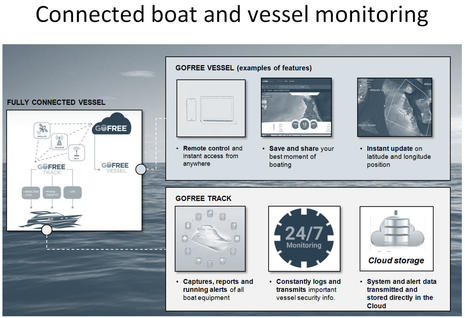 I’ve had Navico’s impressively powerful GoFree Track monitoring hardware installed on Gizmo for several months now, and while all Vessel services except the lowest level free WiFi SD are still in development, I think that’s because Navico is so ambitious about what’s possible. They don’t just want to provide every consumer boat monitoring feature so far imaginable, as suggested in the slide above.
I’ve had Navico’s impressively powerful GoFree Track monitoring hardware installed on Gizmo for several months now, and while all Vessel services except the lowest level free WiFi SD are still in development, I think that’s because Navico is so ambitious about what’s possible. They don’t just want to provide every consumer boat monitoring feature so far imaginable, as suggested in the slide above.
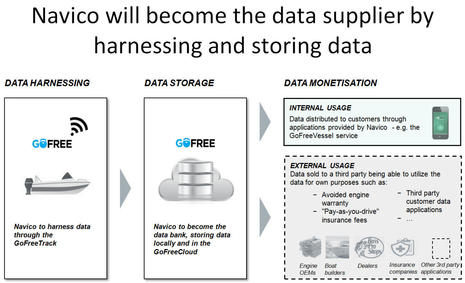 Navico also wants to sell specific or anonymized boat monitoring data to various third parties. That idea may disturb some boaters concerned with privacy, and I’m pretty sure they will be able to opt out, but I’m one of many who gave up on such privacy quite a while ago, and I see some benefits. Giving my engine and/or boat builder access to monitoring logs could help me, for instance, and wider anonymous data sharing might help boating in general, and, of course, I also like the idea of subsidized costs.
Navico also wants to sell specific or anonymized boat monitoring data to various third parties. That idea may disturb some boaters concerned with privacy, and I’m pretty sure they will be able to opt out, but I’m one of many who gave up on such privacy quite a while ago, and I see some benefits. Giving my engine and/or boat builder access to monitoring logs could help me, for instance, and wider anonymous data sharing might help boating in general, and, of course, I also like the idea of subsidized costs.
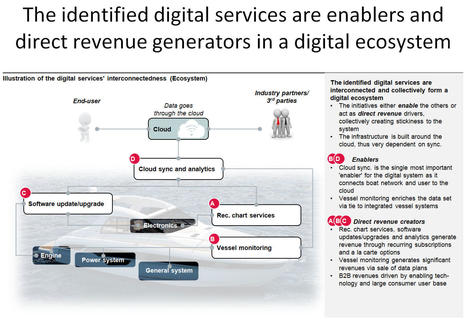 This slide is a little more specific and also seems like a “note to self” for Navico, which so far has not made cloud sync really easy. While the Track system will be great at monitor data syncing, it’s the multifunction displays that need to connect for software upgrades and chart purchases. The separate GoFree WiFi1 network device works OK in my experience, but it’s good that all the new MFDs have WiFi built in, and I understand that eventually Navico WiFi will support simultaneous client and access point modes. That means that the MFDs can feed GoFree and third party apps on mobile devices around the boat while also being connected to the cloud and maybe even onboard sensors like radar, quite like what Raymarine MFDs can do now, and what will likely become the norm.
This slide is a little more specific and also seems like a “note to self” for Navico, which so far has not made cloud sync really easy. While the Track system will be great at monitor data syncing, it’s the multifunction displays that need to connect for software upgrades and chart purchases. The separate GoFree WiFi1 network device works OK in my experience, but it’s good that all the new MFDs have WiFi built in, and I understand that eventually Navico WiFi will support simultaneous client and access point modes. That means that the MFDs can feed GoFree and third party apps on mobile devices around the boat while also being connected to the cloud and maybe even onboard sensors like radar, quite like what Raymarine MFDs can do now, and what will likely become the norm.
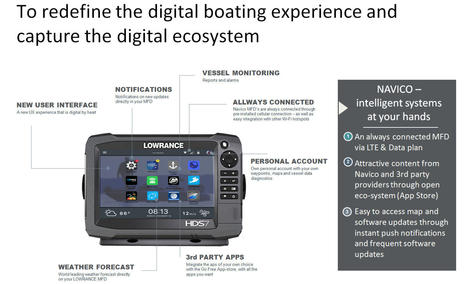 This final slide is where Leif Ottosson’s presentation became truly aspirational and darn interesting, I think, as long as you understand that the MFD envisioned does not exist yet. It’s always cloud connected by WiFi or built-in LTE 4G, the vessel monitoring seems to be integrated, and it looks like more independent third party apps are available through Navico’s app store. The concepts make sense to me, but can Navico or any of the big players in this relatively small industry get there in the near future?
This final slide is where Leif Ottosson’s presentation became truly aspirational and darn interesting, I think, as long as you understand that the MFD envisioned does not exist yet. It’s always cloud connected by WiFi or built-in LTE 4G, the vessel monitoring seems to be integrated, and it looks like more independent third party apps are available through Navico’s app store. The concepts make sense to me, but can Navico or any of the big players in this relatively small industry get there in the near future?
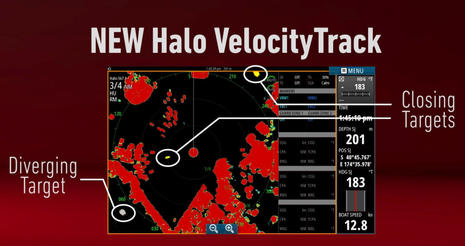 Well, here’s one taste of the future. The new VelocityTrack feature for Halo radars is a lot like the Doppler-assisted MotionScope seen in the Garmin Fantom solid state radars or, if desired, it can simply highlight closing targets like the Furuno NXT radome’s Target Analyzer does, all of which is good news. What’s different is that VelocityTrack will be sold as an unlockable premium add-on, probably for about $500 with the whole transaction and upgrade possible directly from a boat’s online MFD.
Well, here’s one taste of the future. The new VelocityTrack feature for Halo radars is a lot like the Doppler-assisted MotionScope seen in the Garmin Fantom solid state radars or, if desired, it can simply highlight closing targets like the Furuno NXT radome’s Target Analyzer does, all of which is good news. What’s different is that VelocityTrack will be sold as an unlockable premium add-on, probably for about $500 with the whole transaction and upgrade possible directly from a boat’s online MFD.
This should not be unsettling to current and prospective Halo owners given the price differential with Garmin’s Fantom open arrays, and Navico has more premium unlocks in the works. An interesting possibility with feature unlocks is a free trial period during which a boater could try the add-on in real conditions on their own boat (though apparently that may be hard to implement in current NOS). Another possibility might be MFD auto notifications if, say, you were passaging north across the Gulf of Maine and hadn’t yet purchased the VelocityTrack feature (though I think we were joking).
Business
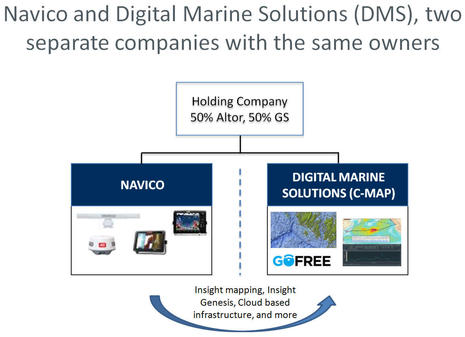 Ottosson also discussed the business side, which is at least highly reconfigured since parent Altor acquired C-Map — now set up as Navico sibling Digital Marine Solutions (DMS) — and then both were purchased by a newer Altor fund in partnership with Goldman Sachs. This means that there’s more money available for growth and Leif wasn’t shy about more “significant acquisitions” in the works, most likely in Simrad commercial marine (though NOS carries through all segments). I also learned that the Goldman Sachs investment is from the partners’ own funds, and that Navico champions with GS are actively helping with the growth plan.
Ottosson also discussed the business side, which is at least highly reconfigured since parent Altor acquired C-Map — now set up as Navico sibling Digital Marine Solutions (DMS) — and then both were purchased by a newer Altor fund in partnership with Goldman Sachs. This means that there’s more money available for growth and Leif wasn’t shy about more “significant acquisitions” in the works, most likely in Simrad commercial marine (though NOS carries through all segments). I also learned that the Goldman Sachs investment is from the partners’ own funds, and that Navico champions with GS are actively helping with the growth plan.
Also noted in the slide above is how the various GoFree mapping and cloud services are moving to DMS, which makes sense given the brand independence promised for C-Map.
 In fact, C-Map also presented at Hawk’s Cay and while their first new product family will be C-Map Insight Pro and Lake Insight especially for Lowrance, B&G, and Simrad MFDs, they are adamant about their willingness to work with other display manufacturers. For instance, Raymarine confirmed that its new Axiom Series and LightHouse 3 operating system will eventually work with C-Map cartography.
In fact, C-Map also presented at Hawk’s Cay and while their first new product family will be C-Map Insight Pro and Lake Insight especially for Lowrance, B&G, and Simrad MFDs, they are adamant about their willingness to work with other display manufacturers. For instance, Raymarine confirmed that its new Axiom Series and LightHouse 3 operating system will eventually work with C-Map cartography.
Even more telling of Navico’s big tent integration style, I think, is the appearance of Navionics SonarChart Live and Dock-to-dock autorouting in the latest NOS56 updates. I saw SonarChart Live running quite well off Hawk’s Cay, above, but be warned that Dock-to-dock will not work in U.S. waters due to a patent conflict.
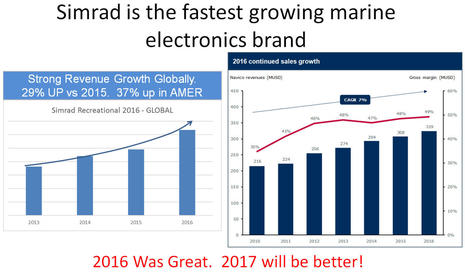 Leif also shared some numbers and was particularly proud of Simrad’s purported 37% growth in the Americas during 2016, as well as overall global revenue reaching 319 million dollars. Interestingly, arch rival Garmin recently released financials showing 16% marine growth to 331 million for 2016, and FLIR (Raymarine) grew its maritime segment to about 186 million according to their recent reports. The latter may contain a significant commercial element — and Furuno does not break down its roughly 668 million USD 2015 marine revenue — but the entire global recreational marine electronics industry is not much more than one billion dollars. If it wasn’t already obvious, the big boys have very large slices of a relatively small pie.
Leif also shared some numbers and was particularly proud of Simrad’s purported 37% growth in the Americas during 2016, as well as overall global revenue reaching 319 million dollars. Interestingly, arch rival Garmin recently released financials showing 16% marine growth to 331 million for 2016, and FLIR (Raymarine) grew its maritime segment to about 186 million according to their recent reports. The latter may contain a significant commercial element — and Furuno does not break down its roughly 668 million USD 2015 marine revenue — but the entire global recreational marine electronics industry is not much more than one billion dollars. If it wasn’t already obvious, the big boys have very large slices of a relatively small pie.
In summation, I think that Leif Ottosson articulated the fully integrated future of marine electronics very well, and also how Navico can get there. But he also noted that Navico has to be an even bigger company to best make the vision work, and while he’s well equipped in that department, the competition is fierce.
Hobie/Elite Fun
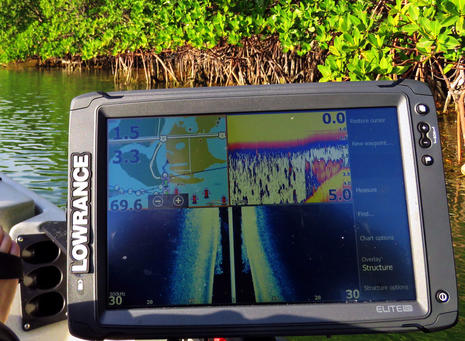 If you’ve stayed with me all this way, thank you, and maybe you too would now enjoy some quiet time on a Hobie Mirage Pro Angler like the ones I fell for at the 2016 Hawk Cay event. This year some genius moved the demo to Curry Hammock State Park and I also got to see what it’s like to small boat with a new Lowrance Elite-12 Ti. While the sonar goodness emanating from the TotalScan transducer neatly integrated into the kayak’s bottom was not very evident in this shallow spot, it looked great in deeper areas, and it’s worth noting that, according to Lowrance, the Elite Ti was the globe’s biggest selling family of MFDs last year even though it then only came in 5- and 7-inch sizes.
If you’ve stayed with me all this way, thank you, and maybe you too would now enjoy some quiet time on a Hobie Mirage Pro Angler like the ones I fell for at the 2016 Hawk Cay event. This year some genius moved the demo to Curry Hammock State Park and I also got to see what it’s like to small boat with a new Lowrance Elite-12 Ti. While the sonar goodness emanating from the TotalScan transducer neatly integrated into the kayak’s bottom was not very evident in this shallow spot, it looked great in deeper areas, and it’s worth noting that, according to Lowrance, the Elite Ti was the globe’s biggest selling family of MFDs last year even though it then only came in 5- and 7-inch sizes.
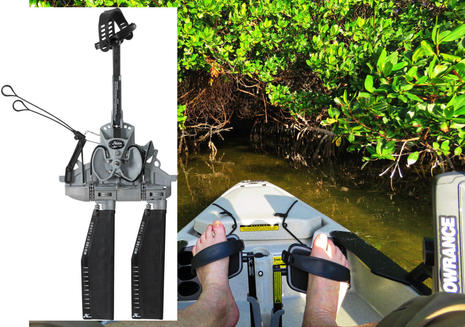 What really blew me away, however, is that the Hobie Mirage pedal drives now have reverse. It’s called MirageDrive 180, it’s standard on all 2017 Mirages, and it worked great for me. For instance, after I nosed into that creeklet above — which was on the Elite’s Insight chart, to my surprise — I was able to back out simply by yanking on the red cable. And then when I cast into the fish I’d seen there, but of course caught a mangrove branch instead, I still didn’t need the paddle for maneuvering.
What really blew me away, however, is that the Hobie Mirage pedal drives now have reverse. It’s called MirageDrive 180, it’s standard on all 2017 Mirages, and it worked great for me. For instance, after I nosed into that creeklet above — which was on the Elite’s Insight chart, to my surprise — I was able to back out simply by yanking on the red cable. And then when I cast into the fish I’d seen there, but of course caught a mangrove branch instead, I still didn’t need the paddle for maneuvering.
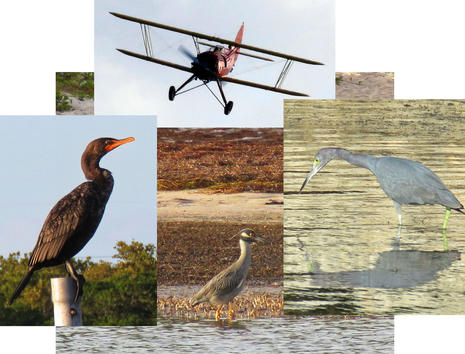 The 180 drive also makes the Mirage even better for bird photography, and I happily went aground and off again numerous times. I also enjoyed checking out a terrifically accessorized (Albin?) trawler peacefully anchored in the park (below). Note the Torqeedo-powered tender, the large solar array on a rack also stowing a pair of windsurfers, and what I thought the pièce de résistance – about a dozen inexpensive solar lawn lights arrayed so that this beauty must sparkle after sunset.
The 180 drive also makes the Mirage even better for bird photography, and I happily went aground and off again numerous times. I also enjoyed checking out a terrifically accessorized (Albin?) trawler peacefully anchored in the park (below). Note the Torqeedo-powered tender, the large solar array on a rack also stowing a pair of windsurfers, and what I thought the pièce de résistance – about a dozen inexpensive solar lawn lights arrayed so that this beauty must sparkle after sunset.
But I became somewhat concerned when no one appeared on deck during my harbor meander. Perhaps the owner was suffering the same truism I know too well?
“Cruising is the time you get to enjoy between fixing pumps.”
I feel fortunate because I usually enjoy fixing boat systems almost as much as using them. But, dang, wouldn’t it be grand if a lot more boat components got well integrated, start to finish, into a central system, and the whole deal a lot smarter?


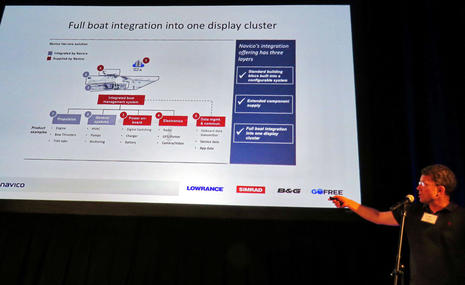
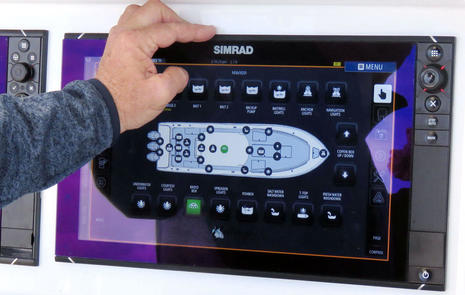
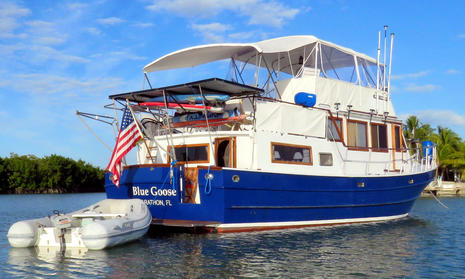
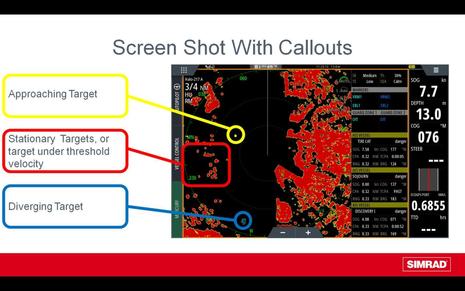
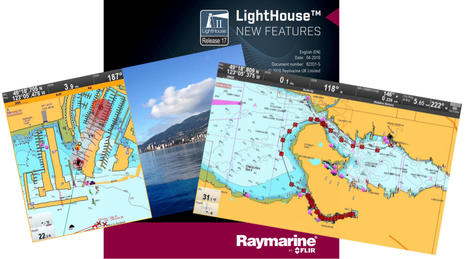
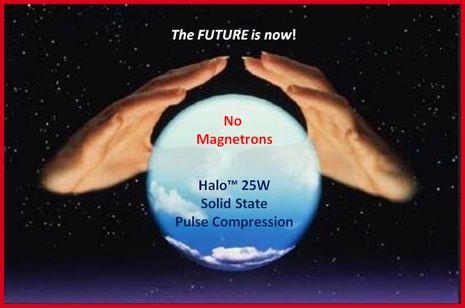
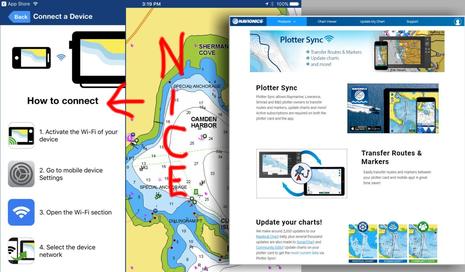








Ben,
Longtime reader thanks for the help.
Quick question is this GoFree only available to tie into Navico brands like Simrad, B/G and Lowrance? Or is it a stand alone unit that can link up to my display? I’m only interested in Satellite. I have Raymarine A-series 12′ Also, where can you purchase the GoFree hardware? I called navico and the lady had no idea about Gofree or how/if it can tie into my Raymarine unit. She linked me up with a guy name Phil up there but have yet to hear back.
Thanks again,
Mike
The fully integrated vessel is a noble goal and is a marketing ambition for many in the marine industry.
However there are a range of issues that need to be discussed including:
1) A single integrated system is the only answer from some stakeholders. As the defence and aerospace industries have proven the loss of situational awareness from a single system is a huge issue. Both in terms of training good operators and for maintaining mission critical capability for degraded systems.
2) Security needs to be the starting point. The current crop of marine electronics options are not built on hardened systems. This is not negotiable.
3) Open source in terms of software, integrations and interfacing is the only way to scale. The current crop of closed solutions means we have to trust the vendors to do the right thing. Experience has shown this to be a flawed approach. It’s expensive for the consumer and results in us having to accept some pretty poor performing solutions
4) The current crop of hardware (based on my recent upgrade using one of the big names) has highlighted the following issues. Poor performance, buggy displays, insufficient compute and IO capability exacerbated by non optimized code are just a few of the issues experience in the field.
5) Documentation is dreadful. Lkely a consequence of the closed source approach adopted by all vendors
6) Once users have an integrated system then liability rears its ugly head. Basically whoever has the capacity to pay will be the subject of litigation. Stoopid is stoopid whether technology is involved or not.
7) Hardware vendors traditionally are not great at creating, building and supporting software. The industry needs to move from its current amateur base to a more professional software footing. Not withstanding the great work done by the current software leads innovating in the industry. I can’t see this happening under the current closed source model.
Hi Mike, GoFree Track and Vessel are not tied to Navico MFD systems at all. I imagine that might happen in time, with some feature bonuses, but Track is designed as an independent monitoring and control system with standard I/O’s like NMEA 2000, J1939, serial and analog. It’s also scaled to many boat sizes. Navico has a large market in mind, and I believe that’s why GoFree is being moved to DMS, joining C-Map as a slightly distant relative to the B&G, Simrad, and Lowrance brands.
Also, Track comes WiFi only or WiFi/Cellular with the Iridium satellite connection an add-on, and I don’t think it’s truly on the market yet, though I believe that several charter companies and testers like me are ready to go when the more advanced software materializes.
By the way, a telling phenomenon I slowly realized in Miami is that about every monitoring company there — I’ll cover several new and interesting ones — had been visited by Garmin 😉
As a pokey old 37′ sailing catamaran owner all I can see is $$$$ going to the suppliers. While the total integration may be a nice feature for White Boat owners who have deep pockets the lowly cruiser is being forgotten I feel. I need an reliable MFD that has good chart capability, a reliable autopilot, AIS so the big boats can see me and I can see them. Total integration in the automotive market is about as proprietary as you can get. OBD II isn’t the answer if you can’t do anything with it unless you have the auto manufacturers dealer support system to make changes (Peugeot Planet anyone). Closed charting systems (are you listening Garmin) are not on. Raymarine has the right idea. Ever since FLIR took them over they have moved a long way from one of the most closed systems to one of the more open ones. I applaud this movement. So call me skeptical and I’ll stick with my little system. It gets me safely around the coastal regions of Australia.
John and Leftbrain, a whole lot of people love their very closed automobile systems, not to mention their quite closed Apple ecologies of hard and soft ware. That’s just a fact.
I find open source marine tech like SignalK and OpenCPN fascinating, but they remain a very small niche. Interestingly, Android was mentioned in one of the Navico “future” slides I left out, though not explained by the CEO, and in Miami I saw a new Android MFD from Si-Tex that looked quite powerful.
Ben,
Thank you for the posting on Navico. I have a keen interest in what Navico is doing because I replaced most of my electronics in 2014 with the Navico/Simrad NSO evo2 products.
As I read your posts and replies to questions above, I am encouraged about the direction but am very concerned at the same time. My concerns are based on experience with Simrad over the past three years –
1) The Simrad support is not up to supporting such an integrated system. I have had to remove my NSO evo2 processor and send it back to Navico for replacement. I had many thousands of dollars charged to my credit card for the unit shipped to me, until my unit was received by Navico. For a boat that is doing approx. 5,000 miles a year through 18 states, coordinating the shipping schedule was complicated.
2) Simrad’s dealer network is not ready to support such a complicated service. I had my system installed by an authorized dealer to gain the additional warranty years. When I have had problems with the NSO evo2 box, or the Sonar Hub (replaced once) or the RS35 radio (replaced twice), the dealer’s only answer was – call Simrad 800 number. This winter, I have a several issues to resolve. I contacted a different dealer on the west coast of Florida, where I had purchased some equipment last year. Their response to my request for service was – let us contact Simrad, and then I received a call from Simrad Support. When I explained the issues between my NSO evo2 and autopilot, support advised me to contact a dealer. SO…I have called dealers who will be in the areas we will be traveling through in the next 4-6 weeks.
3) If Navico wants to integrate all the boat systems, the user interfaces need improvement. The data bars configurations are very basic (example – wind speed as a current number vs Maretron’s N2KView wind speed graph). The data bar configurations are not saved so each time I do a software update or replace the processor, the settings are lost and must be recreated.
4) The C-Map cartography model needs to catch up with the times – when I found several areas with chart errors, C-Map sent me new SD cards with updated data. To do that, they snail mailed me new cards and I had to mail my old cards back. Why can they not download the data like Navionics does with their updates? Especially with the GoFree network.
5) Did you see any cellular data interfaces much like our cars have?
This looks great, but indeed fills me with sheer horror. The design contains several critical components that down the boat if a single component fails. Nearly every component is connected to the same bus, and one rogue component brings communication down. The system is lacking redundancy. Getting there would come at a significant price point, and would run into the issue that the consumer components are not designed for that, as the M/V Tanglewood adventures show.
I agree that the marine installers are unlikely prepared to service this system. But they are not the only one’s to blame. These devices come with barely any serviceability, no meaningful debug screens, diagnostic functions, nada. For this reason, trying to solve issues is essentially limited to replacing devices, as you never know whether you are facing a hardware issue, a software bug, an intentional but unknown behavior, or just a cabling problem. With limited tools installers have at hand and the fact that capex-wise they cannot stock all these toys, support is constrained to calling 1-800 and getting a new device, or hoping for the next update. Things are getting worse as technology evolves. Compare diagnosing RS422 (easy) to the (somewhat closed, but documented) CAN/N2K, to the completely closed Ethernet buses manufacturers move to.
I am happy to accept this for ever cheaper consumer equipment like my TV. I am reluctantly willing to accept it for a car, which can stop anytime without threatening my safety and where the car mechanic can fix it in due course (with expensive, but excellent diagnostic equipment provided by manufacturer). I am not willing to accept it on a 7-digit asset like a boat, where failing tech puts my safety at risk.
We should have a look at professional marine electronics. Decentralized to some degree, excellent diagnostic functions, etc. The dealers should push for this. It protects their value proposition and their bottom line. Why do they accept being degraded?
We have a B&G Zeus2 and a B&G Zeus on board.
Navico deserves praise for their brave attempt to bring at least some of their devices (Zeus2) online. For instance, the ability to send a “report” to customer service is much appreciated and very useful. I sent in a report last year and another just today. The experience with the guy on the other side being able to see my system was priceless and led to much better service than usual.
Just today, I configured PredictWind on the Zeus 2 and it works! However, not all is perfect:
1. Last year the GoFree Shop was not working in November. At all. As customer service confirmed. Today the Shop comes up, but it does not let me purchase nor download anything. I would have liked to throw $235 bucks to the Shop today, to be able to have a Navionics chart on the Zeus2 so that Navionics Chartplotter Sync would work on my system (a Navionics chart on the Zeus2 is required for this functionality to start up on both the “Navionics iPad app” and the Zeus2).
2. It is nifty to use PredictWind (PW) on the Zeus2, but it is unlikely we’ll ever use it from the Zeus2. The PW app’s user interface is 1000% easier to use than in the clunky Zeus2.
Looking forward to a Zeus3 sometime down the road, to see if it addresses the general clunkiness of using web services on the Zeus2 !
Thanks, Xavier. I agree that Navico has some work to do with system WiFi and the GoFree store, but obviously the pressure is on. To me PW weather routing looked easy on the Zeus2, and isn’t it a nice bonus to built the routes on the plotter? Also, I’d love to hear how well Navionics Plotter Sync works if you get there.
Peter Daum, I really hope that you look into the Navico NASA diagnostic reporting Xavier just endorsed:
https://panbo.com/archives/2016/09/navico_nasa_moves_tech_support_to_the_cloud.html
And I simply do not understand how modern systems fill you with “sheer horror”? Exactly which “critical components” can down a boat if a single component fails?
In my experience most modern installs have some redundancy built in and more is easy to add. If a GPS receiver fails on many boats these days, another one will automatically take its place, or can be chosen from a list available on most MFDs and instruments. If an MFD fails completely, there’s often another that can do all the same functions. If, say, a radar was plugged into that completely failed MFD, the operator only has to move the plug elsewhere, and in most cases the system will reconfigure itself no problem.
Installing completely separate NMEA 2000 and Ethernet networks on a boat — as required on some commercial vessels — is not that hard, but then again I have not heard of many complete network failures.
WOW!! Lets go! Great Stuff Ben! Very exciting times in marine electronics product development again!! Perhaps we are going to see a market increase in recreational revenue over the next few years since it seems continued integration is the plan. Meaning continued integration with other consumer electronics off the boat=increased revenue per sale plus increased services etc.
The open source community and the 3rd party developers programs may he a very appropriate vehicles to helping Navico fuel and increase this as you reported. When Goldman Sachs gets in you know an increase of liquidity in the industry is occurring or may be about to. !! Look forward to seeing and learning more on this great unfolding story Ben!!
Thanks so much.
John Neyland Jr.
That’s the spirit, John! It’s a much, much smaller world but there are parallels with the gigantic battle taking place between Google, Apple, Amazon, etc.
Navico, Garmin, FLIR etc. can similarly see whole ecologies of boat components and services that they could own with the right development, partnerships, and acquisitions.
As for Goldman Sachs, the name may make many people shutter, but I don’t know that the reputation has anything to do with the specific investment in Navico. Apparently some GS partners have a real interest in marine electronics and are helping out.
I remember the fears when Navico was first owned by the Altor equity funds — it would be “parted out” or somehow damaged for short term gain — but that is not at all what happened here in the real world.
Ben,
Is the GoFree Track hardware available to be purchased?
Good question, HenryD. Mike — the first commenter in this thread — called Navico without results and I don’t see GoFree Track available anywhere online…so I’d say no, not yet really available. The hardware I received in November seems quite finished but so far the only service available is basic SD WiFi, so I guess that software is the hold up.
All this connectivity between instruments including transducers putting the data on a screen is fabulous. But I think for many not practical and to expensive. Even with a network… one needs to have compatible devices… and upgrading can get spendy. But I suppose one can do this in piecemeal. I oppose having all black box instruments with only access to data on one “MFD” or more if you can afford and have the real estate.
As I get older I am having more and more difficulty operating hi tech devices which are loaded with features/software/apps etc with a couple of buttons to use to get at all that good stuff. Yet my 5 yr old grand daughter can pic up any “screen” device or use my windows pro to get to whatever she wants to see.
Who knew?
Naples (Italy) – FairWind: when marine electronics, open source and the University meet – NauticSud 2017 – Mostra d’Oltremare di Napoli
Naples (Italy), 20/02/17 – FairWind, already awarded 1st in the category Apps and Videogames during the 3rd edition of the Italian science exhibition Futuro Remoto 2016, has been unveiled in its latest release at the University of Napoli Parthenope booth with the presentation titled “FairWind: when marine electronics, open source and the University meet”.
The app was born and developed in the Department of Science and Technology, Parthenope University in Naples, Italy, and it is continuously upgraded by a cross-curricular and dedicated team. A working prototype running on UDOO QUAD (http://udoo.org) was on demo during the event “NauticSud 2017”.
“FairWind is a multidisciplinary and interdisciplinary project where the diverse and different research lines currently running at the Department of Science and Technologies, already Faculty of Nautical Science of the Naval Institute of Napoli now UniParthenope – claimed Raffaele Montella, assistant professor in Computer Science and FairWind project leader. Moreover, FairWind features can be applied in many different areas of interest: from marine sector to environmental science and edutainment.”
FairWind is an integrated multifunctional navigation software based on open technologies leveraging on an infrastructure built on mobile and web technologies. It is also defined as “Android-based Smart, Cloud-Enabled Navigation System for small Yachts with Boat Apps for never-ending custom improvements”. FairWind is an academic research-prototype project with the final aim to collect coastal marine data to be used for better understand and protect local ecosystems.
FairWind collects board data from NMEA0183*, NMEA2000* and SeaTalk* data sources with open source/open hardware interfaces based on Futura Elettronica Fishino Mega (http://fishino.it) or using high quality certified marine electronics as the Digial Yachts iKommunicate (http://ikommunicate.com ). The collected data are stored and produced to other apps using the SignalK (http://signalk.org) open marine data format. With FairWind you can use position data from the on-board GPS with nautical chart apps on an Android tablet. A demo application based on UDOO Neo and Vufine+ (http://vufine.com) shows navigation data in an augmented reality environment. The FairWind application is available on the Google Play Store. In order to gather data from on-board electronics, a free license is needed.
The team members currently are: Raffaele Montella, Team Leader; Diana Di Luccio, Data management; Carmine Ferraro, Developer; Federica Izzo, Social Media Marketing & Communication. For further information on FairWind and its applications: http://fairwind.uniparthenope.it
Chart integration: Navionics just acquired Wavey Line, the small company that’s been creating and maintaining charts from the northern Bahamas to the DR for many years:
http://www.navionics.com/en/news/navionics-announces-acquisition-wavey-line
I don’t know how this may affect the other cartography companies that license Wavey Line data:
http://www.waveylinepublishing.com/charts/electronic-charts/
Just another lurk over the fence, I like the part when some captains give feedback and admit they are unable to get their bridge to full use and find the layout combersome and restrictive at times.
Norwegian shipyard and design bureau Ulstein in my view builts the most beautiful offshore vessels of all sorts to date, extremely innovative and kick ass ships.
There’s also a superyacht project in the makes, cruise ships and yachts are new to them.
https://www.youtube.com/watch?v=7A1zgxTlsck
Cheers,
Jan
Good Evening Ben,
As i sit in a no wake zone in Hobe Sound FL, it occurred to me that m car GPS tells me what the speed limit is, but my boat does not. It might help people slow down, as ICW signs are often confusing. Do any manufacturers offer that feature?
Best,
Maldwin
What’s the situation with patent conflict with Autorouting in the USA? Any idea if Navico is working out a license for the patent?
So little discussion of the “not available in USA” for autorouting for Navico(B&G/Simrad/Lowrance) & Navionics products.
JMc ~_/)~
Hi John, there are few people I know at these companies who are willing and/or able to talk about patent disputes. In fact, most don’t even want to focus on it themselves as there’s a fair amount of friendliness (and crossover) amongst the product, marketing and sales people.
But that said, the conflict between Navico and Garmin does seem a bit more prominent, and apparently it’s Garmin that holds a US patent on at least some aspect of autorouting. I have heard that it expires soon, but beyond that rumor, it’s all a bit of mystery to me. Raymarine, Humminbird and maybe others seem able to support autorouting in U.S. waters from Navionics, C-Map, etc., but Navico does not, though, for instance, it has recently added other advanced Navionics features:
https://navionics.com/en/NOS56news
Simrad VelocityTrack Doppler enhancement is out for Halo radars. Yes, it took a while, but it looks good and the Info PDF explains the technology better than I’ve seen before:
http://www.simrad-yachting.com/en-US/Products/velocitytrack/